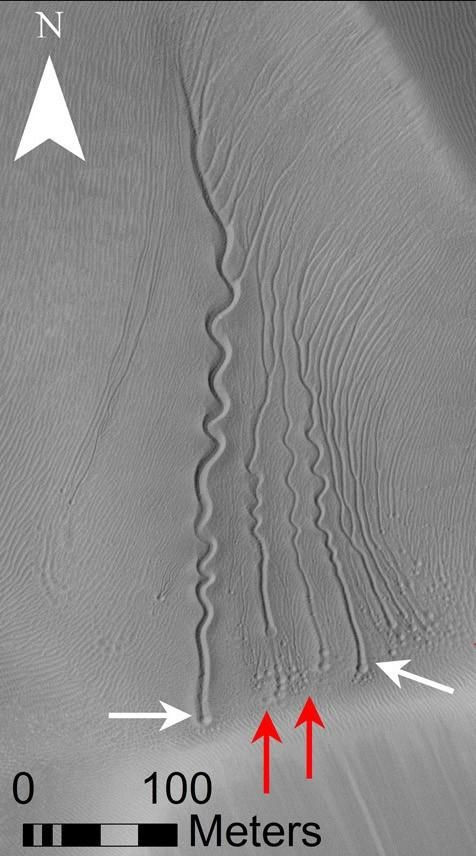Ice On Mars: Sublimation Cause Giant Carbon Dioxide Ice Blocks to Levitate

We have known for years the landscape of Mars is constantly changing. Much like dunes in a desert, observers of the red planet have noticed constant changes on the surface of Mars. A research conducted by a team from Trinity College Dublin has chalked these changes to a simple physical process called sublimation.
The process in which a substance changes from solid to gaseous state without going through an intermediate liquid phase is called sublimation. The team described the phenomenon as unlike anything seen on Earth.
The study was published as a report on website EurekAlert on Oct.27.
PhD student Lauren Mc Keown said in the report, “We've all heard the exciting news snippets about the evidence for water on Mars. However, the current Martian climate does not frequently support water in its liquid state — so it is important that we understand the role of other volatiles that are likely modifying Mars today."
"Mars' atmosphere is composed of over 95% CO2, yet we know little about how it interacts with the surface of the planet. Mars has seasons, just like Earth, which means that in winter, a lot of the CO2 in the atmosphere changes state from a gas to a solid and is deposited onto the surface in that form. The process is then reversed in the spring, as the ice sublimates, and this seasonal interplay may be a really important geomorphic process."
Mary Bourke, co-author of the paper, has been observing and recording the changes on the surface of Mars for many years now. Overtime, she had discovered unique markings on the red planet.
"Several years ago I discovered unique markings on the surface of Martian sand dunes. I called them Sand Furrows as they were elongated shallow, networked features that formed and disappeared seasonally on Martian dunes. What was unusual about them was that they appeared to trend both up and down the dune slopes, which ruled out liquid water as the cause."
These gravity-defying markings have baffled scientists for a while now. Initially, it was explained through cryo-venting, a process whereby CO2 gas beneath the surface of Mars and its seasonal ice deposit erodes complex patterns on the dune surface when the ice fractures and releases the trapped gas in a huge dust and gas geyser. This could last several minutes. The gas, which is trapped under the red planets’ ice deposits, escapes as seasons change.
According to the report, “The researchers designed and built a low humidity chamber and placed CO2 blocks on the granular surface. The experiments revealed that sublimating Carbon Dioxide can form a range of furrow morphologies that are similar to those observed on Mars.”

The linear gullies witnessed on the surface of Mars can also be explained by this process. These long, sometimes sinuous and narrow carvings are formed by CO2 ice blocks, which fall from dune brinks and 'glide' downslope.
Mc Keown said: "The difference in temperature between the sandy surface and the CO2 block will generate a vapor layer beneath the block, allowing it to levitate and manoeuvre down slope, in a similar manner to how pucks glide on an ice-hockey table, carving a channel in its wake. At the terminus, the block will sublimate and erode a pit. It will then disappear without a trace other than the roughly circular depression beneath it."
"While gullies on Earth are commonly formed by liquid water, they almost always terminate in debris aprons and not pits. The presence of pits therefore provides more support for a hypothesis whereby CO2 blocks are responsible for linear gullies," she added.
After conducting tests, the team concluded levitating blocks of ice left linear gullies on Mars. To simulate and prove this, they slid blocks of dry ice onto a sand bed on the low humidity chamber, which they built, mimicking the conditions found on Mars.
The researchers found “stationary blocks could erode negative topography in the form of pits and deposit lateral levees. In some cases, blocks sublimated so rapidly that they burrowed beneath the subsurface and were swallowed up by the sand in under 60 seconds.”
Professor of Geohazards Jim McElwaine in Durham's Department of Earth Sciences said, "This process is really unlike anything seen to occur naturally on Earth - the bed appears fluidised and sand is kicked up in every direction. When we first observed this particular effect, it was a really exciting moment."
© Copyright IBTimes 2024. All rights reserved.





















